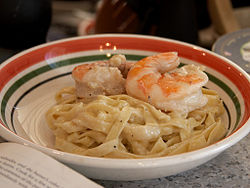Fettuccine Alfredo

Fettuccine alfredo is a pasta dish made from fettuccine pasta tossed with Parmesan cheese, butter, and often heavy cream. As the cheese melts, it thickens the liquids to form a smooth and rich coating on the pasta. It is an American dish, essentially the same as the Italian dish, Fettuccine al burro 'fettuccine with butter' or al burro e panna 'with butter and cream'; in Italy, the name 'Alfredo' is rarely used and the sauce is never named or prepared separately from the dish.[1] In American cuisine, it is often mixed with other ingredients such as parsley, garlic, shrimp and chicken.
Prepared Alfredo sauce is also sold separately, in which case it must be thickened with starch.
History
Pasta tossed with cheese and butter or cream has a long history both in Italy and abroad.[2]
It was popularized among American tourists in Rome by the restauranteur Alfredo di Lelio, who served it with his own name attached:
Fettuccine al burro is associated in every tourist's mind with Rome, possibly because the original Alfredo succeeded in making its serving a spectacle reminiscent of grand opera.[3]
The restaurant's story is that the dish was invented by di Lelio at his restaurant Alfredo alla Scrofa in 1914 as a variation of fettuccine al burro. When butter was added both before and after fettuccine was put in the serving bowl, the butter was known as doppio burro (double butter). Di Lelio's original contribution was to double the amount of butter in the bowl before the fettuccine would be poured in, thus a triplo burro (triple butter) effect instead of double.
As the story goes, Fettuccine Alfredo became extremely popular, and di Lelio's restaurant attracted many celebrities. Two of these were Mary Pickford and Douglas Fairbanks, who fell in love with the dish while on their honeymoon in 1927, and gave him a golden fork to serve it. On their return to the United States they asked for the same recipe, and thus introduced it to the New World. It was also no doubt popularized by the opening of branches of the original Alfredo's in New York and the EPCOT Center in Orlando.
Despite the story, references to Fettuccine alfredo in American books and newspapers are sparse until about 1980.[4] Fettuccine Alfredo has now become ubiquitous in Italian-American restaurants in the United States, though in Italy, it is mostly served to American tourists.
Variations
There are many modifications to the basic Fettuccine Alfredo which are used to lower the cost and quality. Cheaper cheeses, such as U.S.-made imitation Parmesan cheese, are often used; the cheese is sometimes mixed with flour as a thickener. Occasionally, other cheeses such as Asiago and Romano may be added to alter the flavor.
In order to make it a single-dish meal, chicken and vegetables are often served on top. Another variation uses egg in combination with cream, butter and cheese.
Alfredo sauce
Alfredo sauce is sold nowadays as a convenience food in many American grocery stores. Unlike the original preparation, which is thickened only by cheese, pre-prepared versions are thickened with starch.
References
- ^ Vincenzo Buonassisi, Il Nuovo Codice della Pasta, Rizzoli, 1985. ISBN 88-17-11038-8. This compendium of 1347 pasta recipes never uses the name 'alfredo', nor do other well-known Italian cookbooks such as Ada Boni's.
- ^ See, for example, the citations in [1].
- ^ Waverly Root, The Food of Italy, Random House, 1971, p. 86. ISBN 0-394-72429-1.
- ^ Checked using Google Book search and Google News search, December, 2006
External link
- Alfredo L'Originale di Roma
- Food Network's Fettuccine Alfredo
